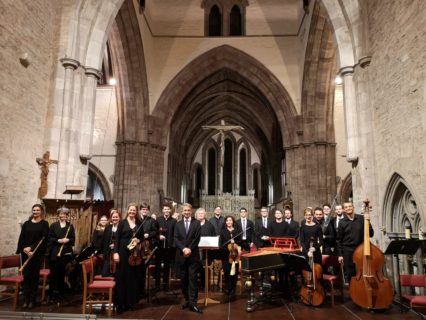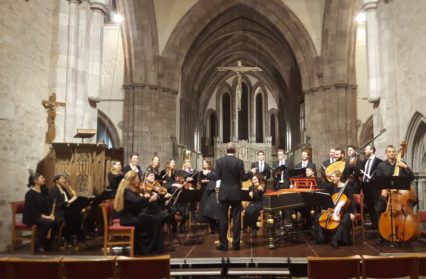Ahead of tonight’s final performance of the Brecon Baroque Festival, Cath Barton explores the music of Zelenka and Biber, amongst others, as she attends two special performances during this year’s festival.
Who has heard any music by the Bohemian composer Jan Dismas Zelenka? Those who have studied the Bohemian Baroque maybe, but I knew nothing of Zelenka’s work before going to the opening concert of this year’s Brecon Baroque Festival, centred around his rarely-performed Missa Dei Patris (1740).
Artistic Director Rachel Podger took as the theme for the 2019 Festival Bohemia: From Biber to Mozart. In parallel with the music composed for the protestant church in Germany during the eighteenth century, in catholic Bohemia – the present-day Czech Republic – composers were writing music which, to those of us for whom J S Bach is the apogee of the Baroque, is surprising in its variety and innovative elements.

Directing the players of Brecon Baroque, led by Podger, Robert Hollingworth brought out all the fizz and frenzy of Zelenka’s music in this mass written towards the end of the composer’s life and intended as part of a larger Missae ultimate which he did not complete. In his opening remarks, Hollingworth compared Zelenka to a dog with a bone, and this certainly evoked the spirit of this music which seemed to pre-figure that of later composers. It was not without reason that Hollingworth pointed out that this was not Mozart; he could have mentioned Haydn and Rossini too.
The acoustics of Brecon Cathedral can swallow sound, but even in the back of the nave, the balance of instruments and voices in the mass movements was well achieved, with singers from Hollingworth’s I Fagiolini and the University of York choir The 24 sounding clear and bright alongside the sharply-focused playing of the strings and oboes of the Brecon Baroque ensemble.
The Kyrie and Gloria of the mass were separated by Lamentation 1 pro Dei Mercurii Sancto (1722), from a set of six composed for Holy Week by Zelenka. This showed the composer’s reflectively dramatic side, with much use of melisma on keywords, pulsing strings and an intricate weaving together of vocal and instrumental textures. Baritone George North was the assured soloist. After this came a short organ fugue by Pachelbel. No, he wasn’t a Bohemian, but this served as a kind of aural palate-cleanser before a return to the virtuosity of the mass.
The Credo, which opened the second half of the concert, is the part of the mass that can trip up composers with its demands for contrast through an extended text. I could hear that Zelenka’s treatment of the Crucifixus might have been influenced by the Italian Antonio Lotti’s wonderful settings for unaccompanied voices, but without reaching the still centre that Lotti achieves.
With his chromaticism and delight in the dance, Zelenka’s music in this mass is full of energy, but I was left a little dissatisfied by the florid excess. Good reason, then, to have had another insertion between the Credo and the concluding sections of the mass, and this by the early Baroque composer lauded for his innovative works for solo violin, Biber. In his Rosary Sonata 11 (The Resurrection)(c.1675) he uses a scordatura tuning which involves crossing over the violin’s two middle strings below the bridge. It is the equivalent of the twentieth-century prepared piano, enabling the player and listeners to explore a new and unexpected sound world. Rachel Podger played with her characteristic flair and dynamism.
The music of Biber also featured in a lunchtime concert on the following day. In contrast to the cavernous stone reaches of Brecon Cathedral, the beautiful wooden interior of Plough Chapel provided a warm acoustic for music from the chamber ensemble FIGO. The group’s name is Italian for ‘cool’ in the sense of ‘on trend’, appropriate for a quartet of young musicians forging a niche for themselves by specialising in Baroque repertoire.
It was good to witness at close quarters the communication between the players – Simone Pirri, Alice Poppleton (violins), Jacob Garside (viola da gamba) and Sergio Bucheli (theorbo) – and to hear their spirited interpretation of Bohemian Rhapsodies, as they titled their programme.
Garside introduced their opening piece, by the French/Scottish composer Georg Muffat who moved to Prague when he couldn’t get a job in Paris. In this Sperantis Gaudia (1695) from his first Florilegium collection, intended for string orchestra, the composer included two viola sections but said in his performance notes that they were not necessary. So FIGO took him at his word and removed them, to no noticeable detriment. The Rondo section in particular was charming.
In the second Sonata from middle Baroque composer Johann Heinrich Schmelzer’s Sonata Unarum Fidium (1664), Pirri’s solo violin traversed elaborate and sparkling variations over a ground bass provided by the viola da gamba and theorbo, while a sonatina by the same composer gave Garside’s gamba the opportunity to play in an imitative manner alongside the two violins.
FIGO’s programme showed the wide range of Bohemia Baroque music for strings, with two sonatas from Gottfried Finger’s 12 Sonatas for Diverse Instruments (1688) demonstrating the capacities and tonalities of the different instruments, including Buceli’s theorbo, its musical character well described by his teacher (so he told us) as a baritone banjo.
This most enjoyable concert was brought to a close with two delightful pieces by Biber: a dramatic solo toccata for viola da gamba and a partita from his Harmonia Artificiosa Ariosa (1696) which concluded with a beautifully judged passacaglia to send us out dancing.
For more information on the Brecon Baroque Festival, click here.
Cath Barton won the New Welsh Writing AmeriCymru Prize for the Novella with The Plankton Collector, which is published by New Welsh Review under their Rarebyte imprint. Her second novella, In the Sweep of the Bay, will be published by Louise Walters Books in September 2020, and in early 2021 Retreat, West Books will publish her collection of short stories inspired by the work of the Flemish artist Hieronymus Bosch.



 Enjoyed this article? Support our writers directly by buying them a coffee and clicking this link.
Enjoyed this article? Support our writers directly by buying them a coffee and clicking this link.







